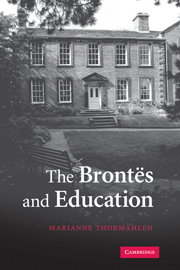1 - The education of the people
Published online by Cambridge University Press: 22 September 2009
Summary
ELEMENTARY EDUCATION: ‘BEHIND THE NEEDS OF THE TIME’
Brontë scholars and Jane Eyre critics have devoted far more attention to Lowood than to the village school for girls where Jane Eyre teaches after running away from Thornfield. That is understandable – the Lowood section is much more extensive, and Jane's experiences there are formative in several ways – but to anyone who wants to explore the interaction between Charlotte Brontë's fiction and the educational issues of her time, Morton school is of peculiar interest. The self-congratulatory tone of the narrator-teacher, closing the premises where she has achieved remarkable results in a matter of months, has a patriotic overtone which is easily overlooked by a modern reader. It would not, however, have been lost on a participant in mid-nineteenth-century debates on education for the people:
I stood with the key in my hand, exchanging a few words of special farewell with some half-dozen of my best scholars: as decent, respectable, modest, and well-informed young women as could be found in the ranks of the British peasantry. And that is saying a great deal; for after all, the British peasantry are the best taught, best mannered, most self-respecting of any in Europe: since those days I have seen paysannes and Bäuerinnen; and the best of them seemed to me ignorant, coarse, and besotted, compared with my Morton girls.
(Jane Eyre III.viii.389)- Type
- Chapter
- Information
- The Brontës and Education , pp. 11 - 23Publisher: Cambridge University PressPrint publication year: 2007



